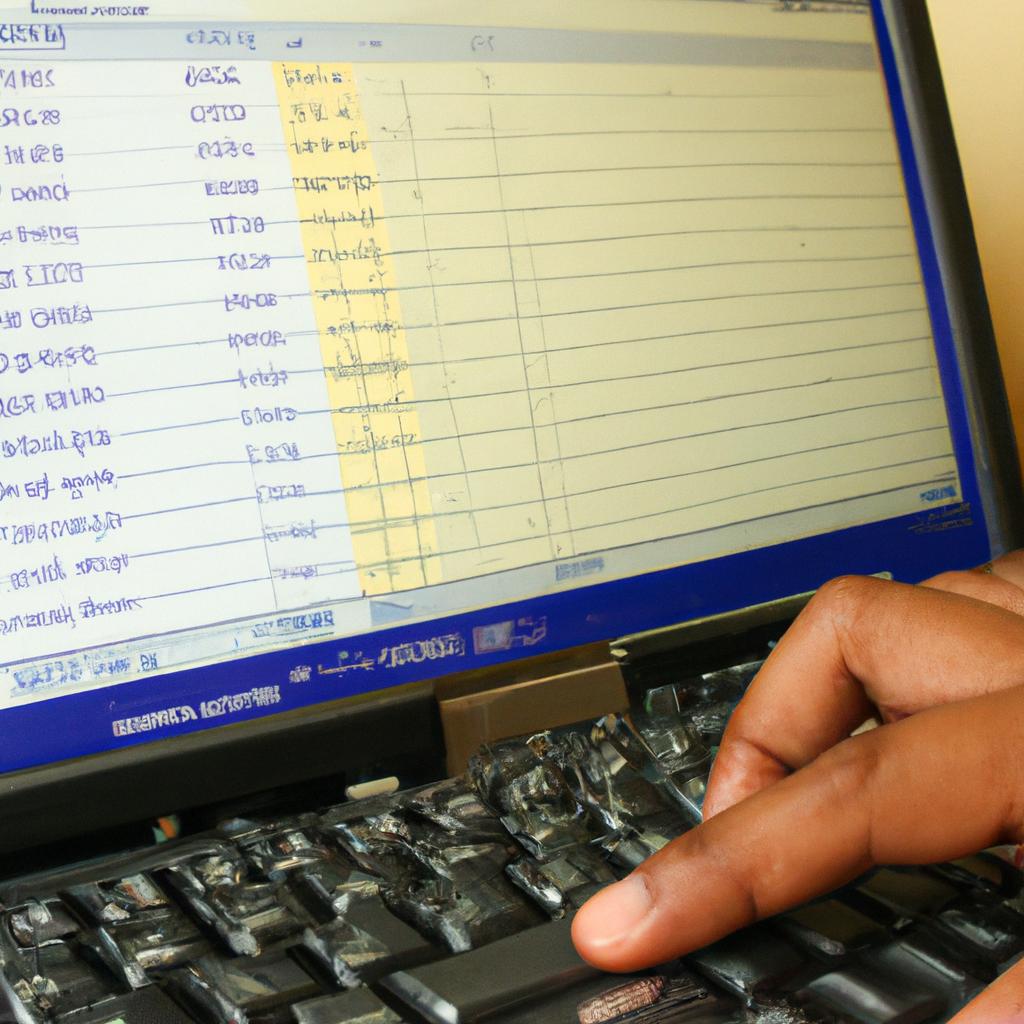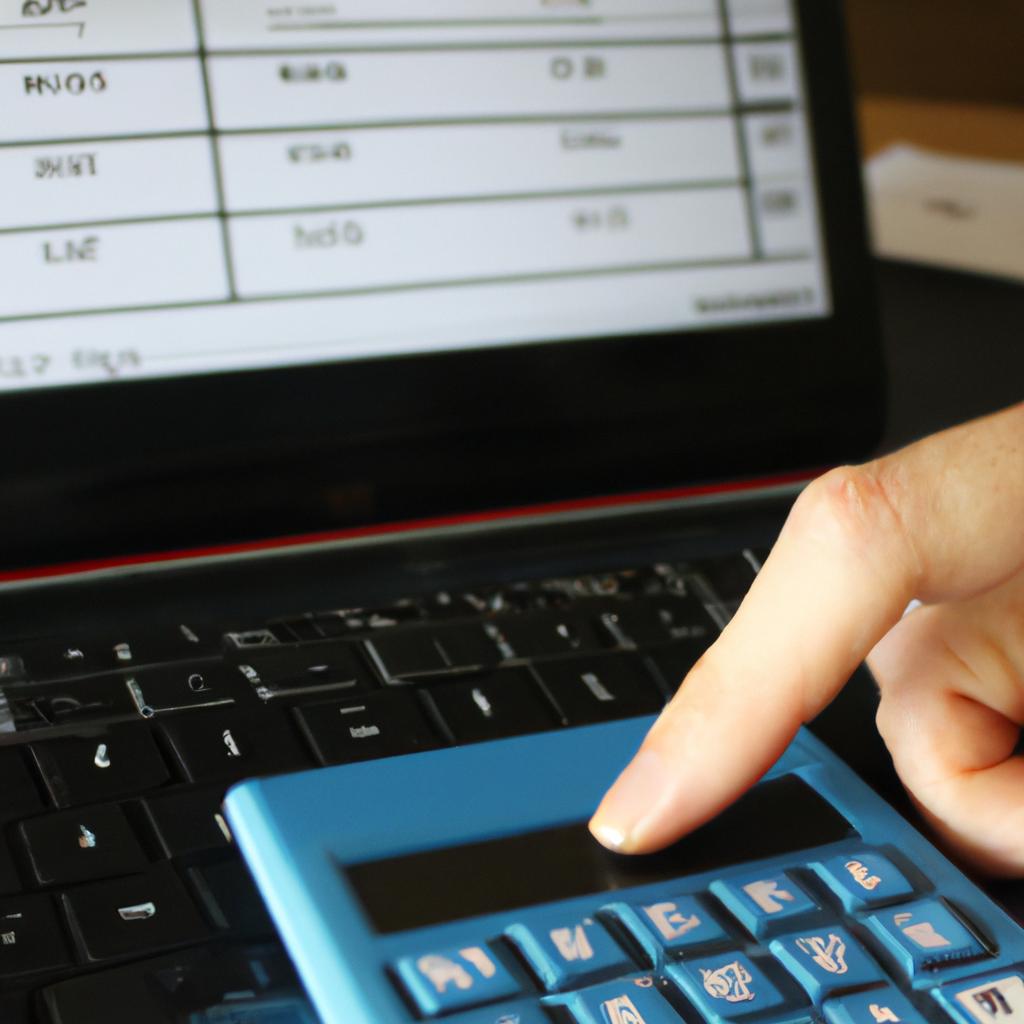General Ledger: A Key Component of Accounting Software for Accurate Financial Reporting

The General Ledger is a fundamental component of accounting software that plays a crucial role in ensuring accurate financial reporting. It serves as the central repository for all financial transactions within an organization, providing a comprehensive record of every debit and credit entry. This article explores the importance of the General Ledger in maintaining the integrity of financial data and facilitating effective decision-making.
To illustrate its significance, consider a hypothetical scenario where Company A experiences discrepancies between their reported revenue and actual cash inflows. By utilizing a reliable General Ledger system, these inconsistencies can be identified and rectified promptly. The General Ledger acts as a trustworthy source of information, allowing accountants to trace back each transaction and verify its accuracy. Without this critical component, organizations would face challenges in accurately tracking their financial activities and preparing meaningful reports for various stakeholders such as investors, regulators, and management teams.
In addition to recording individual transactions, the General Ledger enables organizations to generate vital financial statements like balance sheets and income statements. These documents provide insights into an entity’s overall financial health by summarizing its assets, liabilities, equity, revenues, expenses, gains, and losses. Accurate reporting through the General Ledger ensures compliance with accounting standards while also enabling informed decision-making regarding budgetary allocations, resource planning, investment opportunities, and overall financial strategy.
The General Ledger also plays a crucial role in internal control systems. By maintaining an organized and accurate record of financial transactions, it helps prevent fraud, errors, and misstatements. With proper segregation of duties and regular reconciliation processes, discrepancies or irregularities can be quickly identified and addressed.
Furthermore, the General Ledger facilitates financial analysis and performance evaluation. By providing a comprehensive view of all financial activities, organizations can analyze trends, identify areas of improvement, and make informed decisions to optimize their operations. This includes monitoring expenses, tracking revenue sources, assessing profitability by product or service line, and evaluating the effectiveness of cost-saving initiatives.
Overall, the General Ledger is a vital tool for any organization’s accounting system. It ensures the accuracy and integrity of financial information while providing valuable insights for decision-making purposes. Implementing a reliable General Ledger system is essential for maintaining transparency, complying with regulations, and maximizing the overall financial health and success of an organization.
Overview of General Ledger
The general ledger is a vital component of accounting software that plays a crucial role in accurate financial reporting. It serves as the central repository for all financial transactions and provides a comprehensive view of an organization’s financial health. To illustrate its importance, let’s consider the case study of Company XYZ.
Company XYZ operates in the manufacturing industry and has multiple divisions spread across different locations. Each division regularly engages in various financial activities, such as sales, purchases, payroll, and expenses. Without an effective general ledger system in place, it would be challenging to consolidate these diverse transactions accurately.
To better understand the significance of the general ledger, let us explore some key features:
- Centralization: The general ledger consolidates data from various sub-ledgers into one central location. This consolidation allows for easier analysis and decision-making by providing a holistic view of an organization’s financial position.
- Accuracy: By recording each transaction with detailed information, including date, amount, account number, and description, the general ledger ensures accuracy in financial reporting.
- Audit trail: The general ledger maintains a complete audit trail that tracks every transaction back to its original source document. This feature enables internal and external auditors to verify the accuracy and integrity of reported financial information.
- Reporting capabilities: With robust reporting functionalities, the general ledger can generate essential reports like trial balances, income statements, balance sheets, cash flow statements, and more. These reports provide valuable insights into an organization’s performance and aid in making informed business decisions.
Table 1 illustrates how a well-maintained general ledger can enhance financial transparency within an organization:
| Without General Ledger System | With General Ledger System | |
|---|---|---|
| Accuracy | Low | High |
| Efficiency | Inefficient | Efficient |
| Decision-making | Challenging | Facilitated |
| Compliance | Difficult | Streamlined |
As evident from the case study and features mentioned above, a well-implemented general ledger system is essential for accurate financial reporting. By understanding its significance, organizations can maximize the benefits offered by this critical component.
Next, let’s explore the importance of the general ledger in accounting and its contribution to organizational success.
Importance of General Ledger in Accounting
Section: General Ledger as a Pillar of Accurate Financial Reporting
Imagine a scenario where a business owner receives their financial statements, only to discover significant discrepancies between the reported figures and the actual state of their company’s finances. Such inaccuracies can result in poor decision-making, loss of investor trust, and even legal consequences. To prevent such situations, businesses rely on robust accounting software that includes a key component known as the general ledger.
The general ledger serves as the central repository for all financial transactions within an organization. It records every debit and credit entry associated with revenue, expenses, assets, liabilities, and equity. By providing an organized record of these transactions, the general ledger enables accountants to generate accurate financial reports essential for making informed decisions.
To illustrate the importance of the general ledger further, consider a hypothetical case study involving a retail store chain expanding its operations across multiple locations. Without an effective general ledger system in place:
- Tracking sales at each location would be challenging and time-consuming.
- Reconciling inventory levels across stores would become cumbersome.
- Monitoring cash flow from daily operations would lack transparency.
- Analyzing profitability by location or product line would require manual calculations.
By utilizing a well-designed general ledger system equipped with advanced capabilities like sub-ledgers and integration with point-of-sale systems, this retailer gains several advantages:
| Advantages | |
|---|---|
| Improved Efficiency | The ability to consolidate transactional data from different locations simplifies financial reporting processes and reduces errors significantly. |
| Enhanced Decision Making | Accurate real-time information allows management to make prompt strategic decisions based on reliable insights into performance metrics. |
| Strengthened Compliance | A comprehensive audit trail ensures adherence to regulatory requirements while mitigating fraud risks through transparent tracking of financial activities. |
| Streamlined Analysis | Data consolidation facilitates detailed analysis by various dimensions such as location, department, or product line – enabling better resource allocation and identification of growth opportunities. |
In the subsequent section, we will explore the structure and components that make up a robust general ledger system. Understanding these elements is vital for comprehending how the general ledger ensures accurate financial reporting and contributes to overall organizational success.
[Transition Sentence into Next Section: Structure and Components of General Ledger] With an understanding of the importance of the general ledger in maintaining accurate financial records, let us now delve deeper into its structure and various components to gain insights into its functioning and significance.
Structure and Components of General Ledger
Case Study: To better understand the significance of a general ledger in accounting software for accurate financial reporting, let’s consider a hypothetical scenario. Imagine a medium-sized retail company with multiple stores and an extensive product inventory. Without an efficient general ledger system, this company would struggle to organize its financial data and generate precise reports.
A well-designed general ledger offers several benefits that contribute to reliable financial reporting:
-
Comprehensive Record-Keeping: A general ledger serves as a central repository for all financial transactions within an organization. By recording each transaction accurately, it provides a detailed account history that can be easily accessed whenever required. This level of record-keeping ensures transparency and allows businesses to maintain compliance with relevant regulatory standards.
-
Accuracy and Error Detection: With the help of built-in checks and balances, a general ledger minimizes human error by automatically cross-referencing different accounts involved in each transaction. Inconsistencies or discrepancies are promptly flagged, allowing accountants to identify errors before they have significant consequences on financial statements.
-
Real-time Financial Insights: Timely access to up-to-date financial information is crucial for effective decision-making within organizations. A robust general ledger system enables managers and stakeholders to view key performance indicators (KPIs) at any given time – such as revenue trends, expenses breakdowns, or profit margins – facilitating informed strategic planning and resource allocation.
-
Streamlined Audit Processes: During audits or internal reviews, having an organized general ledger simplifies the process significantly. Auditors can quickly trace transactions back to their original sources, verify accuracy, and ensure adherence to accounting principles without wasting excessive time searching through scattered records.
| Benefit | Description |
|---|---|
| Enhanced Financial Transparency | A comprehensive general ledger promotes transparency by providing a clear overview of all financial activities within an organization. |
| Improved Decision-Making | Real-time access to financial data enables better decision-making by allowing managers to analyze trends, identify areas for improvement, and make informed strategic choices. |
| Efficient Compliance with Regulations | By ensuring accurate record-keeping and adherence to accounting standards, a general ledger system helps businesses maintain compliance with legal requirements and regulatory guidelines. |
| Facilitates Effective Auditing | An organized general ledger simplifies the auditing process by providing auditors with easy access to detailed transaction records, making it easier to verify accuracy and ensure appropriate controls are in place. |
In conclusion, a well-implemented general ledger is an essential component of accounting software for accurate financial reporting. Its ability to comprehensively store financial transactions, detect errors, provide real-time insights, and streamline audit processes makes it invaluable for organizations aiming to maintain transparency, make informed decisions, comply with regulations, and facilitate efficient audits.
Next Section: Benefits of Using General Ledger in Financial Reporting
Benefits of Using General Ledger in Financial Reporting
In the previous section, we explored the structure and components of a general ledger. Now, let’s delve into why using a general ledger is essential for accurate financial reporting.
Imagine a scenario where a company does not utilize a general ledger system. Without this key component of accounting software, it would be challenging to maintain an organized record of all financial transactions. This lack of organization could lead to discrepancies in financial reports and hinder decision-making processes. Additionally, without a general ledger, there would be no central location to track debits and credits, making it difficult to identify errors or fraudulent activity.
To further illustrate the importance of using a general ledger, consider these benefits:
- Enhanced Accuracy: A well-maintained general ledger ensures that all transactions are accurately recorded, providing reliable data for financial reporting.
- Improved Efficiency: By automating the process of recording and categorizing transactions within the general ledger, companies can save time on manual data entry tasks.
- Streamlined Audit Trail: The use of a general ledger facilitates better audit compliance by creating a clear trail of financial information that can be easily accessed during audits.
- Effective Decision Making: Having access to up-to-date financial records allows managers to make informed decisions based on accurate and timely information.
Let’s now take a closer look at how different aspects play vital roles within the structure of a typical general ledger:
| Account Number | Account Name | Debit | Credit |
|---|---|---|---|
| 100 | Cash | $10,000 | |
| 200 | Accounts Receivable | $5,000 | |
| 300 | Inventory | $2,500 | |
| 400 | Sales Revenue | $7,500 |
As shown in the table above, each transaction is categorized with account numbers indicating its type (e.g., cash, accounts receivable). The debit and credit columns record the corresponding monetary values for each transaction. This organized structure ensures accuracy and clarity in financial reporting.
In summary, utilizing a general ledger is crucial for accurate financial reporting. It enhances accuracy, improves efficiency, provides a streamlined audit trail, and enables effective decision-making. By organizing transactions into specific accounts within the general ledger, companies can maintain reliable records of their financial activities.
Transitioning to the next section about “Integration of General Ledger with Other Accounting Modules,” it is important to highlight how the general ledger serves as a key component that connects various aspects of accounting software seamlessly.
Integration of General Ledger with Other Accounting Modules
To fully harness the power of a general ledger in financial reporting, it is crucial to understand its seamless integration with other accounting modules. By integrating the general ledger with other software components such as accounts payable, accounts receivable, and inventory management, businesses can achieve more accurate and comprehensive financial reporting.
For instance, let’s consider an example where a manufacturing company utilizes an integrated accounting system. In this scenario, when a purchase order for raw materials is generated through the accounts payable module, the corresponding entry will automatically be recorded in both the general ledger and inventory management module. This real-time synchronization ensures that any changes or updates made across various modules are accurately reflected in the general ledger.
The benefits of integrating the general ledger with other accounting modules are manifold:
- Streamlined Data Entry: With integration between different modules, data only needs to be entered once and is then seamlessly propagated throughout the system. This eliminates redundant manual entries and reduces the risk of errors.
- Improved Accuracy: The integration ensures that all transactions flow directly into the general ledger without any gaps or discrepancies. This enhances accuracy by minimizing human error and ensuring consistency in financial records.
- Time Efficiency: By automating data transfer between modules, businesses save time on reconciling information manually. This allows employees to focus on value-added activities rather than repetitive administrative tasks.
- Enhanced Decision-Making: An integrated system provides real-time visibility into financial data from multiple perspectives. Managers can access up-to-date reports across different modules simultaneously, enabling them to make informed decisions based on accurate and complete information.
In summary, integrating a general ledger with other accounting modules holds immense potential for improving overall efficiency and accuracy in financial reporting processes. The interconnectedness offered by these integrations significantly streamlines operations while providing timely insights for decision-makers.
| Emphasizing Integration |
|---|
| Centralized Data |
| Real-time Updates |
| Enhanced Efficiency |
In the subsequent section, we will explore best practices for maintaining general ledger accuracy and ensuring reliable financial reporting. By following these guidelines, businesses can leverage their integrated accounting system to its full potential and achieve optimal results.
Best Practices for Maintaining General Ledger Accuracy
In the previous section, we discussed the importance of integrating the general ledger with other accounting modules. Now let us delve deeper into how this integration enhances financial reporting accuracy and ensures seamless data flow across various functions within an organization.
To illustrate this point, consider a hypothetical scenario where a company has separate modules for accounts payable, accounts receivable, and inventory management. Without integration, each module would maintain its own set of records independent of one another. This can lead to discrepancies and errors in financial reporting due to inconsistent or incomplete data transfer between systems. However, by integrating these modules with the general ledger, all relevant information is automatically synchronized and consolidated in real-time.
The benefits of such integration are manifold:
- Streamlined Data Entry: Integration eliminates the need for manual data entry across multiple systems, reducing the risk of human error and saving valuable time.
- Accurate Financial Reporting: With integrated systems, transactions recorded in different modules are automatically updated in the general ledger, ensuring accurate financial statements that reflect up-to-date information.
- Enhanced Decision-Making: A unified view of financial data allows managers to make more informed decisions based on comprehensive insights from different functional areas.
- Improved Auditing Process: Integrated software facilitates easy traceability and audit trails since all relevant transaction details are readily available in one central location.
Let’s now visualize the impact of integration through a table showcasing key advantages:
| Advantages | Description |
|---|---|
| Real-Time Information | Seamless synchronization enables instant access to current financial data |
| Efficient Workflow | Automated processes eliminate redundancy and improve overall efficiency |
| Data Accuracy | Integration minimizes errors associated with manual transfers |
| Cost Savings | Reduced reliance on paper-based documentation leads to cost savings |
With these benefits at hand, it becomes evident why integrating the general ledger with other accounting modules is crucial for accurate financial reporting, efficient workflows, and informed decision-making. By leveraging modern accounting software that offers seamless integration capabilities, organizations can optimize their operations and stay ahead in today’s dynamic business landscape.



